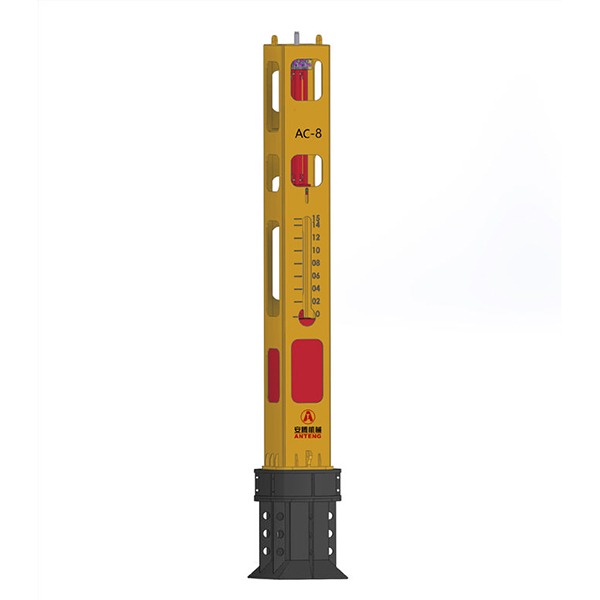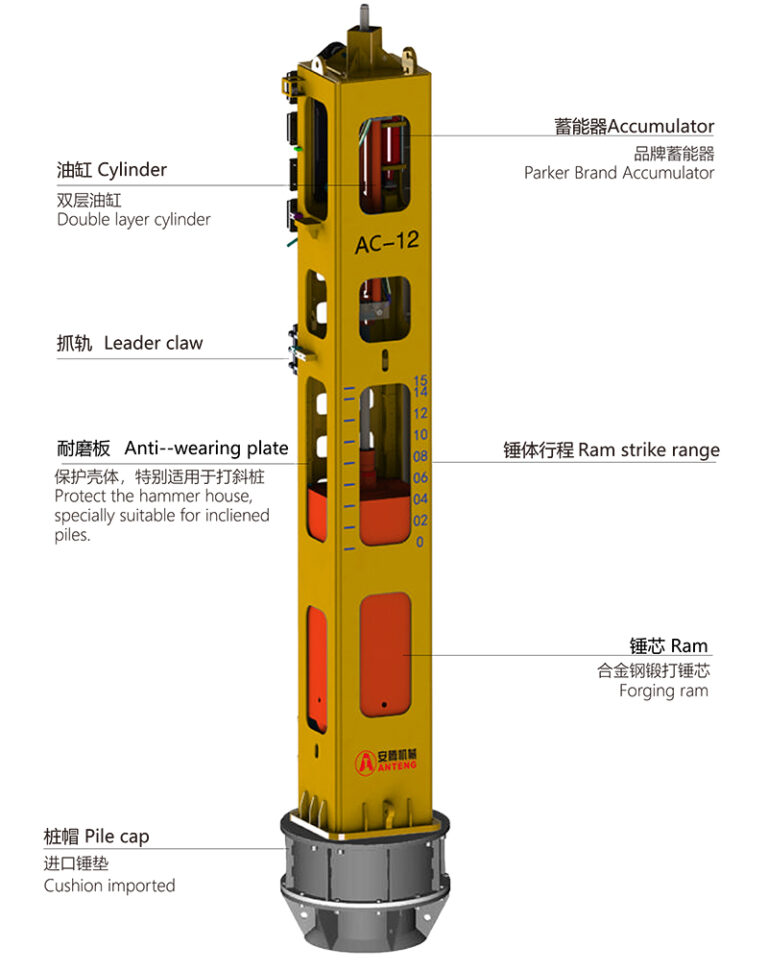Working principle of impact hammer
Related Articles
Share This Article
Overview
The impact hammer is a type of piling equipment that uses impact force to penetrate piles into the ground. It consists of pile hammer, pile frame and auxiliary equipment.

The pile hammer is attached between two parallel vertical leaders (commonly known as gantry) at the front of the pile frame, and is lifted by a lifting hook.
The pile frame is a steel structure tower with a hoist at the rear to lift the pile and the pile hammer. There is a guide frame composed of two leaders in front of the pile frame to control the pile driving direction, so that the pile can be accurately positioned and penetrated into the ground according to requirement. The tower and guide frame can be deflected together to drive raking piles. The guide frame can also be extended down along the tower to drive underwater piles along the embankment or wharf. The pile frame can be rotated and moved.
The basic parameters of the impact hammer are the weight of the impact part, the impact energy and the impact frequency. The impact hammer can be divided into drop hammer, steam hammer, diesel hammer, hydraulic hammer and so on according to the power source of the movement.
1. Drop hammer
- The pile hammer is a heavy steel block, which is lifted by a hoist with a hook, and then falls freely along the guide frame to drive the pile.
2. Steam hammer
The pile hammer is composed of a hammer head and a hammer seat, and is powered by steam or compressed air. There are two kinds of single-action steam hammer and double-action steam hammer.
The single-action steam hammer uses a plunger or a cylinder as the hammer head, and the steam drives the hammer head to rise, and then let it fall along the leader of the hammer seat to drive piles.
The double-action steam hammer generally uses a weighted plunger as the hammer head and the cylinder as the hammer seat. The steam drives the hammer head to rise, and then drives the hammer head to impact piles downward.
The up and down speed is fast and the frequency is high, which makes the pile vibrate and reduce frictional resistance when it penetrates into the soil, and achieve good piling effect. The differential steam hammer with two-way unequal action force has a light hammer seat, the effective impact weight can be relatively increased, and the performance is better.
The reversing of the steam inlet and exhaust valves in steam hammer can be controlled manually or automatically by a flange lever mounted on one side of the hammer head, raised and lowered with the hammer head. Both methods can adjust the impact stroke of the steam hammer.
3. Diesel hammer
The main body is composed of a cylinder and a plunger. Its working principle is similar to a single-cylinder two-stroke diesel engine. The diesel hammer uses the strong pressure generated by the explosion of the atomized diesel fuel injected into the combustion chamber of the cylinder to drive the hammer to work. Diesel hammers are divided into leader type and barrel type according to their structural forms.
The leader type diesel hammer uses the plunger as the hammer seat to press on the pile cap, and uses the cylinder as the hammer head to move up and down along the two leader. When driving a pile, firstly hoist the pile into the gantry of the pile frame, then place the diesel hammer on the top of the pile, lower the hook to hoist the cylinder, and then release the hook to let the cylinder fall into the plunger. The air enclosed in the cylinder is compressed, and the cylinder continues to fall, until the pressure pin outside the cylinder pushes the rocker of the fuel pump on the hammer seat. The fuel pump sprays oil mist into the cylinder, and the oil mist encounters above the ignition point. The high temperature gas will explode immediately. The downward impact of the explosive force causes the pile to sink, and pushes upward to make the cylinder rise. When the cylinder falls along the leader again, the second impact cycle begins.
The barrel type diesel hammer uses the cylinder as the hammer seat, and is directly guided by the lengthened inner wall of the cylinder, eliminating the need for two leaders. The plunger is the hammer head that moves up and down in the cylinder. When driving a pile, press the pile cap at the bottom of the hammer base on the top of the pile, lift the plunger with the hook, and then unhook and hit down, compress the air enclosed in the cylinder, and perform oil injection, explosion, impact, ventilation, etc. process.
The work of the diesel hammer is started by the compression ignition of diesel fuel, so it must be ensured that the closed gas in the cylinder reaches a certain compression ratio. Sometimes when piling on soft soil layers, the reaction force is often too small and the compression amount is not enough to ignite and detonate. So it is necessary to use the hook to lift the hammer for many times to decouple the impact to start. The hammer seat of diesel hammer is attached with a fuel injection pump, fuel tank, cooling radiator and pile cap. The movable gap between the plunger and the cylinder is sealed with an elastic plunger ring.
It uses hydraulic oil as the main working medium and depends on hydraulic pressure to lift hammer. The hydraulic power pack will supply power to the impact hammer through high pressure hydraulic oil hose. When the hammer is lifted up, the oil is drained quickly or the oil is directed to the opposite side. Without oil supply, the hammer falls fast. The impact force produced by hammer falling is used to strike pile. When the pressure pin outside the cylinder pushes the rocker of the fuel pump on the hammer seat, the fuel pump sprays the oil mist into the cylinder, and the oil mist encounters the high temperature gas above the ignition point, and immediately the explosion occur. The explosive force will impact downward to make the pile sink and push upward to make the cylinder rise. When the cylinder falls along the guide rod again, the second impact cycle begins.

